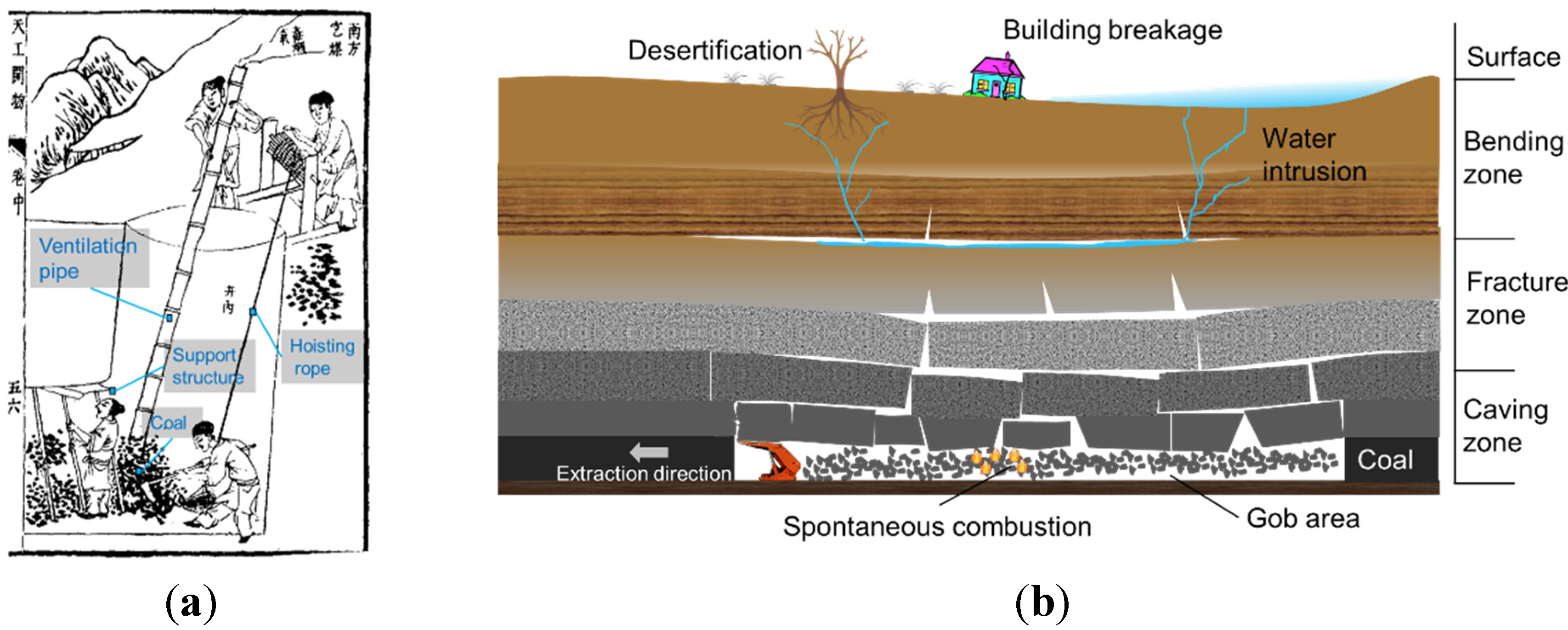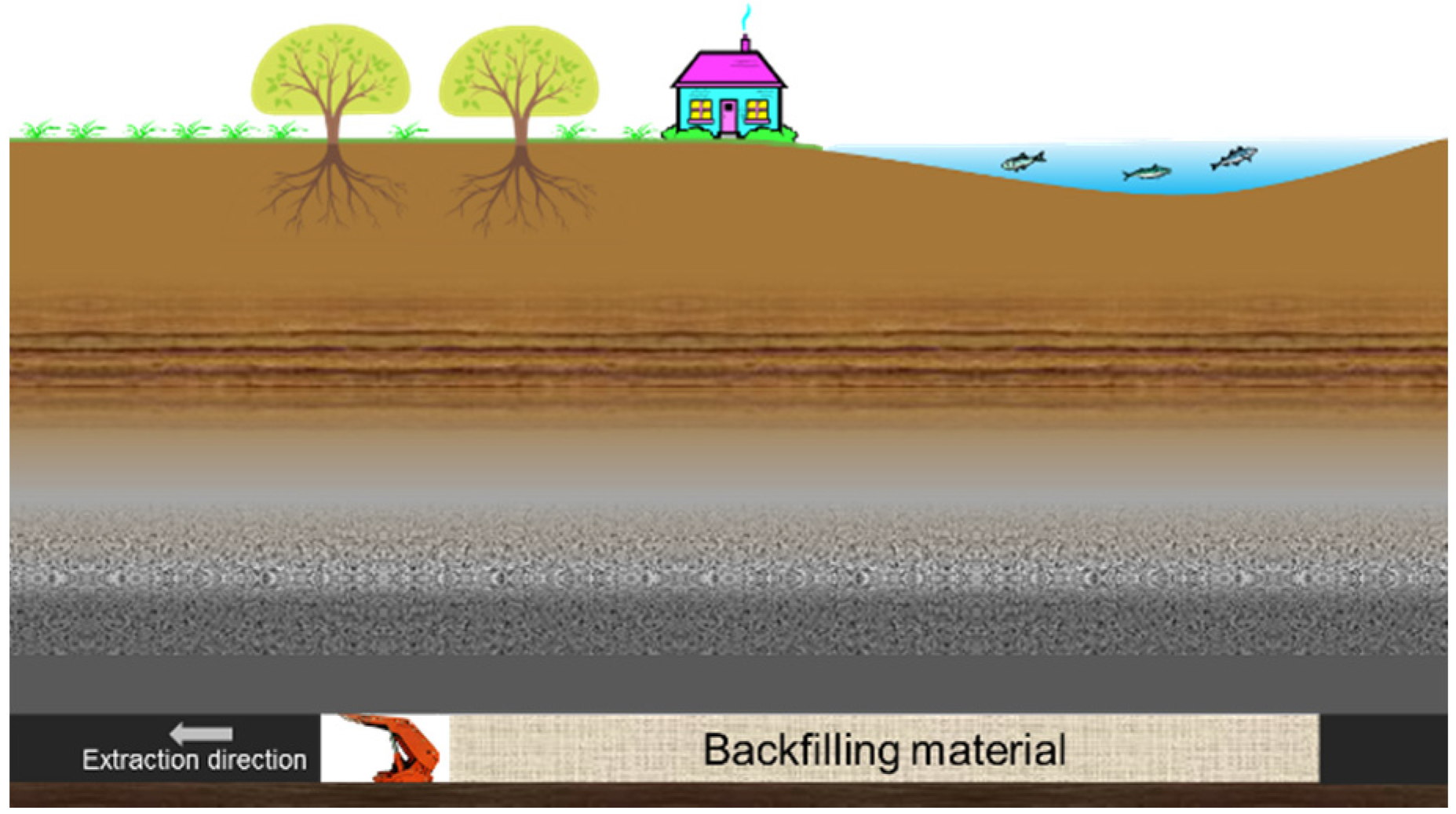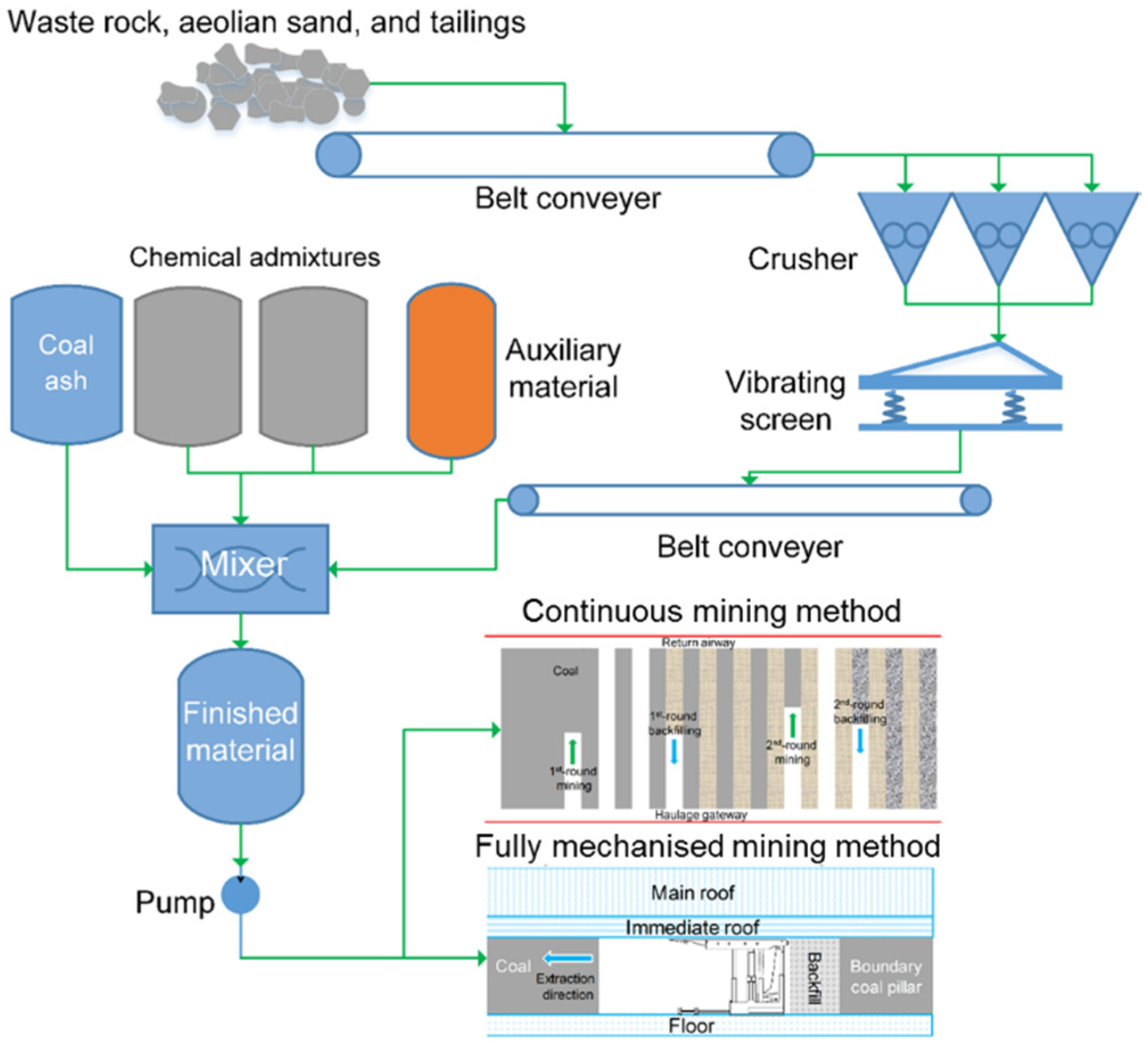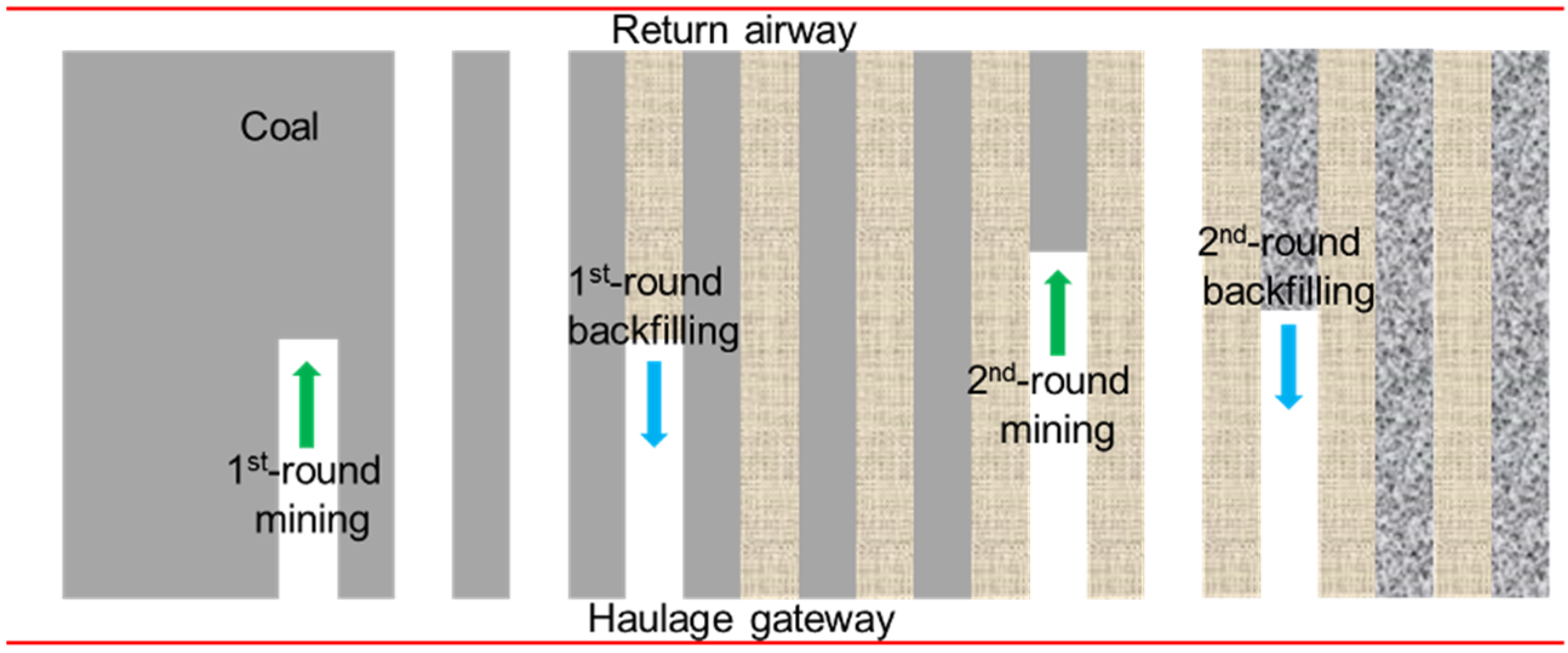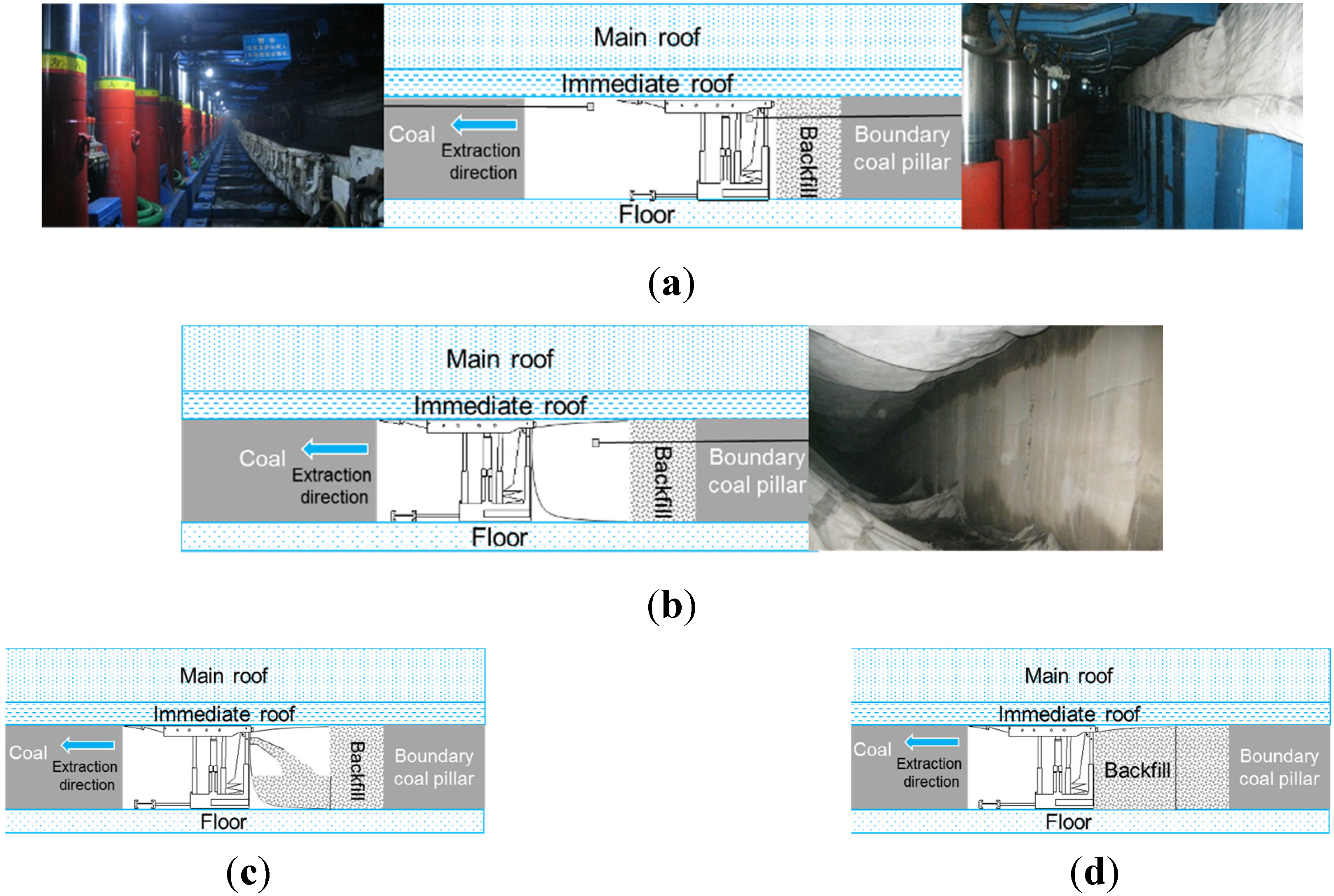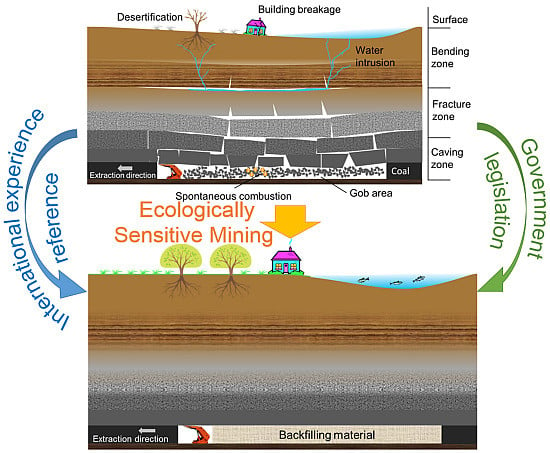1. Introduction
Worldwide, 30.1% of primary energy, 40% of electricity generated, and 70% of steel manufacturing depend on coal, and the total global coal production in 2013 was 7,822.8 Mt. Regional contributions to this total are available from the International Energy Agency and the BP Statistical Review of World Energy [
1,
2]. The data show that China was the largest coal producer (45.6%) in 2013; thus, China continues to play a leading role in environmental disruption even though the nation resolved to reduce the carbon intensity of its economy (the amount of CO
2 emitted per unit of GDP) by 40%–45% during 2005–2020 [
3]. It does not make sense to place greater value on production or economic development than on the protection of our environment, yet the environmental crises resulting from both coal mining and use, including soil erosion, water pollution, surface subsidence, the release of pollutants such as oxides of sulphur (SO
x) and nitrogen (NO
x), and impacts on local biodiversity, persist.
These crises comprise a number of environmental challenges; one such challenge that urgently needs to be addressed is surface subsidence [
4]. Many factors may lead to surface subsidence, such as the collapse of columns underground or invisible karst rivers among strata. The most prominent factor causing subsidence is underground mining [
5,
6]; when a block of sufficient width and length is excavated from a coal field, the original equilibrium state is broken up regardless of whether the mining method used is longwall mining or room and pillar mining. Consequently, rock strata between the immediate roof of the coal seam and the ground surface can be moved. During our research, we investigated coal mine fields in Xuzhou City, where the ground surface has been particularly damaged by underground mining, as shown in
Figure 1. It is clear that subsidence around the coal mine field has become a serious concern, and unlike other issues, such subsidence is not only a technical problem but also a socially relevant issue.
Many studies have been carried out around the world to evaluate surface subsidence for the purpose of developing corresponding countermeasures [
7,
8,
9,
10,
11], but what if we change our approach from the outset, taking measures to prevent this type of subsidence from occurring? A potential solution to these questions may lie in radically preventing subsidence induced by mining activity at its source,
i.e., by using some other material to fill the space occupied by the extracted coal. Traditional schemes include waste rock backfilling [
12], coal ash backfilling, and paste backfilling, among others. With measures such as these, ground surface subsidence can be reduced to some extent. However, backfilling is not mandatory in China’s collieries as this environmentally sound practice has long been perceived as a costly, time-consuming, and low-efficiency engineering method.
Figure 1.
Example of surface subsidence problems induced by underground mining. (a) Surface subsidence around Zhangji Colliery in Xuzhou, at latitude and longitude of 34.3667 and 117.0229, respectively; the mining depth is more than 900 metres; (b) Building damage associated with Zhangji Colliery in Xuzhou, at latitude and longitude of 34.3846 and 117.0315, respectively; (c) Waterlogging around the Pangzhuang Colliery in Xuzhou, at latitude and longitude of 34.3566 and 117.0766, respectively. (Xiaowei Feng and Lianyuan Gong performed investigations around the subsidence areas and obtained these figures by themselves).
Figure 1.
Example of surface subsidence problems induced by underground mining. (a) Surface subsidence around Zhangji Colliery in Xuzhou, at latitude and longitude of 34.3667 and 117.0229, respectively; the mining depth is more than 900 metres; (b) Building damage associated with Zhangji Colliery in Xuzhou, at latitude and longitude of 34.3846 and 117.0315, respectively; (c) Waterlogging around the Pangzhuang Colliery in Xuzhou, at latitude and longitude of 34.3566 and 117.0766, respectively. (Xiaowei Feng and Lianyuan Gong performed investigations around the subsidence areas and obtained these figures by themselves).
Hence, the status since the 1970s has remained the use of backfilling. Currently, a simple, natural caving method in which the roof above the coal seam is allowed to naturally cave in under the effects of gravity is mainly adopted because it incurs no extra cost; this method can easily lead to surface subsidence. It is critical that innovative backfilling methods be developed to create a more ecologically sound “Black Gold” industry, and such methods must provide both economic and technical value.
2. Characteristics of Surface Subsidence Induced by Underground Mining
As a result of continuous sedimentation effects and tectonic movements occurring on the scale of billions of years, the Earth’s surface shows a general trend toward stability, even though seismic activities and volcanism are spread worldwide. However, within the Earth, artificial underground mining poses enormous hazards to the safety of miners and the environment. Surface subsidence induced by mining has long been ignored because governments focus more on financial gains than environmental protection or simply because most people are more familiar with greenhouse gas emissions and naturally consider emissions to be the greatest problem caused by underground coal excavation.
The extraction of underground coal resources has been undertaken for thousands of years in China, according to the record in
The Tiangong Kaiwu, or
The Exploitation of the Works of Nature, a Chinese encyclopaedia compiled by Song Yingxing, initially published in May 1637 (see
Figure 2a). Once excavation occurs within the ground, the overlying rock strata experience subsidence, as illustrated in
Figure 2b. It is clear that the associated damage compensation is much more expensive than the economic profits from excavation. Lakes, rivers, reservoirs, and other water bodies are easily disturbed, causing mine flooding underground, while the surface is subjected to water erosion/pollution, desertification, and building damage.
Figure 2.
Comparison of an ancient mining method and current mechanised mining without backfilling. (a) The ancient mining method described in The Tiangong Kaiwu, published in 1637; (b) The current mechanised mining method; the method is characterised by its caving system, which is both economical and efficient to enable high productivity.
Figure 2.
Comparison of an ancient mining method and current mechanised mining without backfilling. (a) The ancient mining method described in The Tiangong Kaiwu, published in 1637; (b) The current mechanised mining method; the method is characterised by its caving system, which is both economical and efficient to enable high productivity.
Figure 2b also indicates an apparent three-zone division along the vertical direction from the mining level to the surface level—the caving zone, fracture zone, and bending zone. This zone division is based on the degree of fracture of strata overlying the coal seam, and the degree of fracture is in turn associated with the mining method, spatial relationships, geotechnical conditions of the rock strata, and excavation duration [
13]. It is generally thought that these three zones can only develop when the ratio of the thickness of overlying strata to the thickness of the coal seam is greater than 40, but this ratio is surpassed extremely easily in the case of the many 1,000-metre-deep collieries; data show that there are already more than 50 collieries with an excavation depth greater than 1,000 metres in China [
14]. Underground fracturing induces varying hazards on the surface, such as water loss and soil erosion, building damage, and ecological disruption, among others. Moreover, the insufficient backfilling produced by single roof caving behind hydraulic supports is inadequate to prevent the deformation of the overlying rock mass. Some unfilled space can remain in the gob area, which causes problems for the excavation of the neighbouring working face because the dead weight of the surrounding rock mass is only partially supported by the caving gangue in the gob area, and the remaining weight must be transferred to the adjacent intact coal body to maintain stability. In other words, this transfer causes a pressure increase on the neighbouring working face, thus increasing the costs required to maintain stability in the adjacent face. Additionally, it is impossible to realise a one hundred percent of coal recovery ratio, which means certain amount of coal can be left over in gob area, then spontaneous combustion may be incurred under the influence of unstable environment and oxygen in the gob area, which presents a danger to both the efficiency and safety of production [
15]. Surface ecology and construction are also disturbed by subsidence. Such damage is especially predominant in the north-western coal districts of China, like Qinghai Province, Sinkiang Province, Ningxia Province,
etc., where the ecological environment, primarily semi-desert grassland, is extremely fragile. Thus, disturbances underground readily lead to surface water losses and can cause environmental conditions to turn from bad to worse.
Injecting grout into the bed separation in the overburden of coal seams may serve as a solution to this environmental problem [
16]. Such an approach is a remedial measure, though it has long been treated as an effective measure to seal off spaces between strata to resist on-going subsidence, it cannot rehabilitate the ground surface to its original landform. Furthermore, injecting grout can only take place when bed separation does occur between strata, and the costs and technical problems can be much greater than an immediate backfilling method following coal mining. Immediate backfilling is conducted from the outset to backfill the space originally occupied by coal resources (see
Figure 3). This method is a win-win situation from both an economic and ecological perspective.
Figure 3.
Current mechanised mining with backfilling procedure employed (drawing designed by Xiaowei Feng).
Figure 3.
Current mechanised mining with backfilling procedure employed (drawing designed by Xiaowei Feng).
Figure 3 demonstrates that timely backfilling prevents the occurrence of the three-zone division above the coal seam, and the ecosystem on the ground is also minimally influenced. In conclusion, mining that protects water resources and is environmentally friendly, or green mining, is a challenge, and it is urgent that we turn this previously economically driven engineering practice into an ecological engineering practice.
3. Methodology for Surface Subsidence Prevention
As mentioned in the previous sections, the key to preventing surface subsidence lies in the timely filling of man-made spaces underground with alternative materials after excavation. The alternatives can vary from waste rock backfilling [
17], coal ash backfilling and hydraulic sand backfilling to paste backfilling and similar measures. Gob backfilling makes it possible to excavate coal resources trapped under artificial constructions and natural water bodies [
18], and this method is thus increasingly used in underground mines all over the world [
19]. Currently, there are nearly 13.79 billion tons of coal trapped under the aforementioned conditions in key state-owned collieries in China [
20]. To choose the most effective of these alternatives, the following equation can be utilised during practical field trials:
where
M is weight of coal excavated, in tons.
Mʹ is weight of backfilling material to be applied, in tons.
ρ is the density of coal, in tons per cubic metre (1.3 t/m3 for coal, in general).
ρʹ is the density of backfilling material, in tons per cubic metre (1.6 t/m3 for backfilling material, in general).
k is a backfilling factor (0.6–0.95) that varies by system; the general value for coal mines is 0.8.
Based on the above specific values, it can be found that
Mʹ/
M ≈ 1. It is clear that the amount of backfilling material required is approximately equal to the coal production. It is difficult to prepare such a large amount of material and transfer it to the space behind the coal face, especially for measures like waste rock backfilling, coal ash backfilling, and hydraulic sand backfilling as a result of their very one-dimensional technical system. This is the greatest disadvantage to backfilling because of the dramatic increase in cost, which may be twice the production profits from coal excavation. However, among these alternatives, the most effective method is paste backfilling [
21,
22,
23] by mixing waste rock, aeolian sand, or tailings with coal ash and cement. First, a certain amount of chemical admixtures and auxiliary material is added to upgrade the pumpability of the mixture, and then the mixture is pumped to the rear space of the coal excavation line. This approach has the potential to reduce surface subsidence and is a promising method for large amounts of waste reuse [
24]. The aforementioned technical procedure is illustrated in
Figure 4.
Figure 4.
Diagram of underground paste backfilling (drawing designed by Xiaowei Feng).
Figure 4.
Diagram of underground paste backfilling (drawing designed by Xiaowei Feng).
Generally, the objectives of paste backfilling should be as follows: to geotechnically ensure a safe and efficient mining operation; to increase the extraction ratio and decrease water consumption; to decrease soil contamination and surface subsidence; and most importantly, to decrease cost compared with other measures and let the value of Mʹ/M approach 1 as closely as possible because of the backfill material’s expansion ability.
The pumpability of backfill material will dramatically decrease the cost of transportation. Thus, the pumping pressure should be lowered and the hydration time should be increased to allow for longer transportation distances. The backfilling material should possess appropriate expansion and solidification properties to decrease porosity and improve uniformity throughout the gob area when it reaches the excavated site. The material can thus support the roof and prevent the subsidence of overlying strata [
25]. Two mainstream methodologies are used: the first addresses continuous mining faces, and the second is designed for fully mechanised coal mining faces. The schematic details for backfilling methodology in a continuous mining face are shown in
Figure 5, the coal seam is divided into strips by a skip-mining method. The first round of mining leaves a certain width of coal pillars, this preliminary coal excavation is a type of room and pillar method, where pillars are left to support the roof in case of roof collapse or further subsidence of the overlying strata and the coal is excavated for economic profit. At a certain distance from the first-round mining face, the first-round backfilling face is arranged to fill up the space initially occupied by coal mass. These two faces are capable of excavating a certain amount of coal while simultaneously controlling the potential subsidence of the overlying roof. However, nearly half of the coal is left behind, and it is thus proposed to apply a second-round mining face to excavate the remaining coal pillars among the previous first-round backfilling faces. The same volumes of gob area occur when excavating these remaining coal pillars; hence, to thoroughly prevent roof subsidence, a second-round backfilling face behind the second-round mining face must completely fill the gob area. In this type of backfilling method, these four operational sequences are relatively independent. Furthermore, this method both guarantees a high recovery rate of coal and controls surface subsidence. Such backfilling has been successfully employed in the Yuyang colliery in Shanxi Province, where the total subsidence area before backfilling was 4.6398 square kilometres on the ground [
26]. Another successful case is the Xuchang Colliery in the city of Zibo in Shandong Province [
27].
Figure 5.
Schematic illustration of backfilling methodology in a continuous mining face (drawing designed by Xiaowei Feng).
Figure 5.
Schematic illustration of backfilling methodology in a continuous mining face (drawing designed by Xiaowei Feng).
For fully mechanised coal mining, a different backfilling method should adopted to address the unique nature of the coal mining face and equipment used. The hydraulic support is characterised by its backfilling function, which is capable of pumping paste backfilling material into the gob area behind the support. The working procedure can be divided into four steps (see
Figure 6). The movement of the support along the extraction direction allows the mould bag to stretch automatically (see
Figure 6b) thus allowing backfilling material to be pumped in (see
Figure 6c). One cycle is finished when the previously pumped material coagulates, and the process is repeated throughout the coal mining process, as shown in
Figure 6d. Apparently, this approach can also fully pack the gob area and confine the subsidence of overlying roof strata such as the immediate roof and main roof, thus supporting the concept of “green mining” [
28]. The immediate roof generally consists of siltstone, sandy shale, and shale, which can remain stable for a certain period even if the coal seam underneath it has been mined out for some distance, but will eventually sag due to the gap below if no backfilling procedure has been applied. The main roof is much stiffer and thicker than the immediate roof, which will apply greater pressure on the mining face, underlying strata, and related galleries below; this relationship also highlights the importance of utilising backfilling strategies during mining activities. This type of backfilling technology is also widely being used at the Zhucun Colliery in the city of Jiaozuo in Henan Province [
29].
Figure 6.
Backfilling procedure for fully mechanised coal mining with self-backfilling hydraulic supports. (a) The moment when the first-round backfilling neighbouring the boundary coal pillar is finished; the left and right photos, taken in the Yulin colliery of Shanxi Province, indicate corresponding sections in the centre sketch; (b) The left sketch shows the moment when the mould bag stretches as a result of the forward movement of the hydraulic support, which is also indicated in the right photo, also taken in the Yulin colliery of Shanxi Province; (c) Backfilling material being pumped into the rear space formed by the mould bag; (d) End of the first-round backfilling procedure. (drawings in this figure were designed by Xiaowei Feng and photos were taken by Xigui Zheng and Fei Xue in a related field trial in Shanxi Province).
Figure 6.
Backfilling procedure for fully mechanised coal mining with self-backfilling hydraulic supports. (a) The moment when the first-round backfilling neighbouring the boundary coal pillar is finished; the left and right photos, taken in the Yulin colliery of Shanxi Province, indicate corresponding sections in the centre sketch; (b) The left sketch shows the moment when the mould bag stretches as a result of the forward movement of the hydraulic support, which is also indicated in the right photo, also taken in the Yulin colliery of Shanxi Province; (c) Backfilling material being pumped into the rear space formed by the mould bag; (d) End of the first-round backfilling procedure. (drawings in this figure were designed by Xiaowei Feng and photos were taken by Xigui Zheng and Fei Xue in a related field trial in Shanxi Province).
4. Discussion and Future Outlook
National legislation must support both economic development and ecological sustainability. Currently, China is still a developing country with an energy economy that is largely dependent on its coal resources. Although China’s annual coal production accounts for a large part of the global total, the production method applied in collieries still lags behind those used in developed countries such as the United States, Germany, and Australia. Many workers contribute a lifetime of labour, or even their lives, to the national energy industry. Legislation under these circumstances cannot limit the widespread effects of collieries in a short time, which may even cause a hysteresis phenomenon in technical development in coal production. However, legislation addressing the environmental crises induced by underground mining is imperative, and during this process, China can benefit from other countries’ experiences. The Ruhr District in Germany can serve as an example, where land subsidence was extremely serious due to large-scale coal extraction over the past 100 years [
30], yet the regional initiatives implemented by the government since the 1970s have turned this district into a world-renowned “Garden Industrial Zone” in view of its current diversification of economy, emerging industry, environment rehabilitation, and other factors. As another example, consider the United States, where the conflict between environmental protection and growing coal excavation has been on-going since the 1970s. In the Yellowstone River Basin of eastern Montana, the abundant, high-quality water and the nation’s largest coal reserves presented a great conflict of interest because the extraction of the latter requires large volumes of water [
31]. In the late 1970s, south-eastern Montana’s Tongue River basin was experiencing rapid development of its extensive coal deposits, which was greatly impacting the basin’s hydrologic systems, and the Water Use Act required certain adjustments to relieve this situation despite some unexpected restrictions [
32]. Under such a historical background, US president Jimmy Carter signed the Surface Mining Control and Reclamation Act (SMCRA) in 1977. SMCRA is the first mining environmental protection law in the USA, and it provides standards for environmental protection related to mining activity. Simultaneously, the Office of Surface Mining (OSM) was set up to supervise the protection and rehabilitation of environment [
33].
Obviously, experience from these countries should be examined and adjusted based on the unique mining conditions in China. A scientifically feasible and ecologically friendly coal mining industry is a key element for constructing green homes in mine fields, though this notion has only gained attention in recent years in China. Whether the coal mining industry, or “Black Gold” industry, can be realised ecologically depends on both the rationality of the economic structure and the feasibility of its technological background. The government should consider that coal is the main resource for and an extremely reliable source of energy in China, but coal represents a raw product in the national industrial chain and the extent of the nation’s reliance on this industry is still unreasonable. Hence, green mining technology deserves support and concern from the government, which will undoubtedly urge supervisors of collieries to place more importance on the environment while simultaneously avoiding negative influences on the economy. From a technological perspective, more research and investments should be focused on basic study of strata subsidence arising from underlying coal mass excavation, including cost optimisation of the paste backfilling process and related backfilling materials. Moreover, different collieries have different characteristics; it should be emphasised that collieries in eastern China should focus more on how to protect the surface ground and construction, whereas those in western China should focus more on how to protect their fragile ecosystems and barren water system. Ecosystem protection patterns and economic evaluation systems should also be studied, including their relationship with enterprise cost, which can thus guide government legislation.

